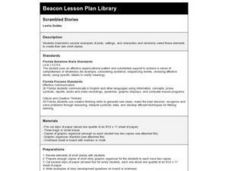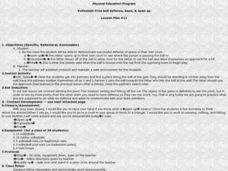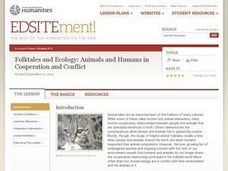Curated OER
Scrambled Stories
Character development, setting, and plot? Sounds like the makings of a good narrative story. Young authors read and analyze several narrative examples, and then they use what they know to pen an original composition. They work both in...
Curated OER
The World Around Me
Combining visual and language arts, here is a resource that prompts middle schoolers to write stories based on pictures of their surroundings. They use digital cameras to take pictures of favorite areas in the school. Next, they choose...
Curated OER
Film Festival: An ESL Lesson Plan to Get Students Talking About Movies
If your ESL pupils love talking about movies, here is an activity ideal for providing practice with both informational reading and elements of a story. Given fictional movie posters, they decipher the information and put it into a...
Curated OER
Lesson Plan 7: The Elements of Story
Budding novelists work on character development by relating to the characters in their stories. They imagine their own hopes and dreams and recall those of characters from books they've read. Learners also consider struggles the...
Curated OER
Varied Beginnings: Research Process / Narrative Writing Techniques
What's the best way to start a story? Learners write a memoir using effective openings. They research the process and work through a list of hooks to use in their writing. They use at least two hooks to begin their personal memoir. A...
Curated OER
Plot/Poetry Review
Before a writer can create a well-composed piece, he/she needs to know the ropes. Review parts of speech, plot, and elements of poetry with this set of questions presented as a PowerPoint. The text, being white, is kind of difficult to...
Curated OER
Lesson Plan 2: Good Novel, Bad Novel
What are the characteristics of a good piece of writing? What makes a story interesting? Give your pupils a chance to define the qualities of good novels and what they see as the qualities of bad novels. Class members record these...
Curated OER
Volleyball - Lesson 20 - Setting up the Attack
It's time to pull all those volleyball skills together in lesson 20! The focus of this lesson is running plays. The setter communicates with her team to set the ball to a certain player and in a specific way. That player will then spike...
Curated OER
Volleyball - Lesson 11 - Free Ball Defense, Base, and Open Up
What positions should the volleyball players be in for a free ball? What position should they be in for a hard hit? Then where do they each move, transitioning to offense? Lesson 11 goes over these questions regarding positioning and...
Curated OER
Volleyball - Lesson 3 - Setting Up to Attack
The focus of Lesson three in this 20 lesson volleyball unit is setting the ball. Proper technique for hand position, contact position, stance, and facing direction are reviewed. These skills are practiced individually and in small...
Curated OER
The Personal Narrative - Part Two
Does your langauge arts class journal frequently? Extend one of your journaling activities by having your writers choose a journal entry and take it through the five stages of writing. They will use the attached graphic organizer to...
Curated OER
Folktales and Ecology: Animals and Humans in Cooperation and Conflict
Story elements such as conflict, character analysis, resolution, and moral are discussed and charted as elementary children read folktales involving animals. An element of science is also introduced as learners discover what a keystone...
Curated OER
Applying Character and Setting to Play Readings
Read Ira Sleeps Over, then identify elements of plays that are also common to books. Learners analyze character and setting, consider how these elements relate to a play, then write a one-paragraph skit using the characters from Ira...
Curated OER
Introduction to Drama
Introduce your class to drama! You cast each pupil as a different character from a story you have read. They are given a general outline of the scene, act out the scene multiple times, then discuss the weak and strong aspects of each...
Curated OER
Plot the Oysters' Peril!
Use comic strips to teach sequencing in narrative poetry. As homework, each class member selects a comic strip with 4-8 frames, cuts the frames apart, places the pieces in an envelope, and brings the envelope to class. Class members swap...
Curated OER
The Too Small House: Story and Craft Activity
Engage students in setting and character with this story and craft activity set. To begin the activity, learners read the short story "The Too Small House." They then cut out and color a picture of the house and paper figures of the...
Curated OER
Maniac Magee: Life Without Problems
Young readers discuss how they would deal with problems faced by the main character in Maniac Magee. They write down their own problems and exchange them with others to analyze and provide possible solutions. They establish a "Dear Abby"...
Curated OER
Story Mapping
Help your learners map a story with a graphic organizer provided. Four squares for setting, problem, characters, and solution surround the circle for theme. Use this with any story you may be reading to go over important elements of story.
Curated OER
The Sand Horse
Fourth graders are introduced to the book THE SAND HORSE and discuss the title and cover illustration. They listen to the story listening for words and phrases to describe the setting. They then brainstorm key words to illustrate the...
Curated OER
Cops and Robbers
Second graders observe the teacher model writing a letter to the author of the book, COPS AND ROBBERS. They then compare the story structure of the book to those of FUNNYBONES and identify the setting, characters and theme.
Curated OER
Puss in Boots/Jamil and the Clever Cat
Second graders read the story PUSS IN BOOTS identifying main characters, setting, and significant events. They then read the story JAMIL AND THE CLEVER CAT and compare it with the story PUSS IN BOOTS compiling a list of characters,...
Curated OER
Story Plan Graphic Organizer
For this story planner graphic organizer worksheet, students fill in the genre, characters, setting, plot, complication and resolution before they use the information to write a story. They also list useful words that will be used.
Curated OER
Cause and Effect Worksheet 2
Why does Scout fear Boo? Why does George kill Lennie? Whether in literature or life, helping young learners recognize the relationship between actions and consequences is an important lesson. Have your class match twelve observable...
Curated OER
Jem in "To Kill a Mockingbird": Fun Trivia Quiz
An in-depth quiz on Jem from Harper Lee's classic novel To Kill a Mockingbird, this quiz combines basic recall skills with some plot and character analysis. Unlike many Fun Trivia quizzes, the content of this quiz deals with plot events...

























